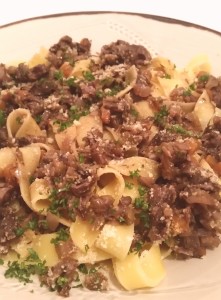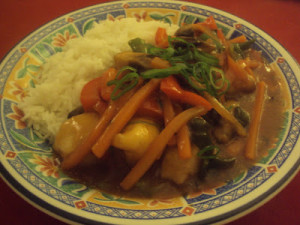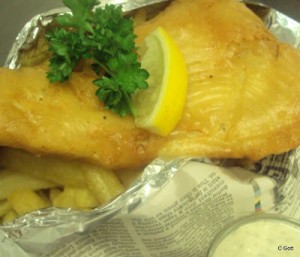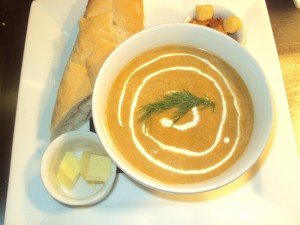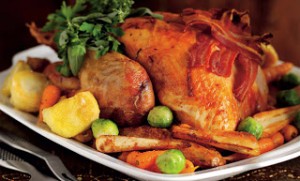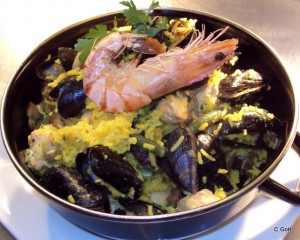With the storms forcing us to all batten down the hatches, I have temporarily swapped the gale force winds in the Channel Islands for the driving rain and bluster of Imogen blowing over Bristol just in time for the rugby. By now we will have had the first weekend’s Six Nations results but it is not too late for a perfect and suitable supper, coq au vin, the rich, satisfying, classic French peasant dish. It is generally accepted that it has a long history as a rustic, rural, recipe, however, it only first appears in cookery literature in the late eighteen hundreds.
The two most popular stories about the creation of the dish involve Napoleon and Julius Caesar, of the two, as a long term Asterix fan, I like the Caesar story.After the conquest of Gaul, now part of modern-day France, the story goes that the natives presented the victor with an old gamey, rooster. The rooster is a tough proposition – excuse the pun and requires long, slow cooking. The rooster was cooked by Caesar’s chef simmered in wine ( a method of cooking extremely popular with the Romans, whatever else did they do for us ? ) and the end result was said to be very successful. Traditionally then the rooster or any tough old bird benefits from first marinating in wine* then gently braising, and the addition of the carcass adds a richness to the finished sauce.
A little Whine ! The Internet has failed to provide me the name of, at a cursory glance, the first person to say that if you would not drink a wine you should not cook with it. I certainly remember the late, great and sadly missed Keith Floyd elucidating, sometimes less than clearly, that this indeed is the case. He certainly was a fan of checking the quality of the vintage he was cooking with at the time. Your coq au vin does not need to be made with a first growth claret but will benefit from a full-bodied robust red. While it could be Australian or from Chile, I am at heart a traditionalist and believe that a Burgundy is best.
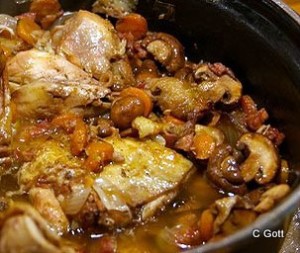 Many regions of France have variants of coq au vin using the local wine, such as coq au vin jaune (Jura) and coq au pourpre (Beaujolais nouveau). In some variations of the dish, white wine is used, Riesling wine is popularly used in the Alsace region, with the addition of Morels and cream. In addition to the wine and chicken coq au vin is flavoured with the inclusion of fat bacon or salt pork, onion, garlic, mushrooms and a bouquet garni (thyme, bay leaf, parsley). The chicken is first marinated in wine, then seared in hot fat, this is essential to flavour and colour the finished dish. The meat, vegetables and aromatics are then simmered in the wine marinade until the meat is cooked and tender.
Many regions of France have variants of coq au vin using the local wine, such as coq au vin jaune (Jura) and coq au pourpre (Beaujolais nouveau). In some variations of the dish, white wine is used, Riesling wine is popularly used in the Alsace region, with the addition of Morels and cream. In addition to the wine and chicken coq au vin is flavoured with the inclusion of fat bacon or salt pork, onion, garlic, mushrooms and a bouquet garni (thyme, bay leaf, parsley). The chicken is first marinated in wine, then seared in hot fat, this is essential to flavour and colour the finished dish. The meat, vegetables and aromatics are then simmered in the wine marinade until the meat is cooked and tender.
* No jokes, please
On a personal note, I find coq au vin an ideal dish for the slow cooker. A good coq au vin improves immensely if you marinade the chicken overnight and improves further if you leave it when cooked, overnight, in the refrigerator. If you cannot get a piece of bacon try to use the thickest rashers, you can find so the lardons will not break up during cooking. Celery is not a staple of many recipes for coq au vin but I agree with Nigel Slater as to the benefits it adds to the resulting dish and have included it below. If you want to peel baby onions you can but I find the result is in no way spoilt by using frozen baby onions. The dish is served in France with flat noodles or rice, it is equally appealing with steamed potatoes that you can crush in the gravy. I personally love a hefty chunk of crusty bread to soak up the juices and a lightly dressed green salad as an accompaniment.
Coq au vin Serves 4
A large chicken, jointed into 6 or 8 pieces, giblets and carcass saved
( ask your butcher if he can source a rooster and if he will cut it up for you )
for the stock
1 Onion, peeled and roughly sliced
1 Carrot, peeled and roughly chopped
1 stick of Celery, washed and roughly chopped
A small bunch of Thyme
A Bay Leaf, a Clove of Garlic and a few crushed Peppercorns
Butchers string
125 gr whole Pancetta or Unsmoked Bacon
2 medium Onions, peeled and finely chopped
2 Carrots, peeled, halved lengthwise and sliced
3 sticks of Celery, washed and finely diced plus one extra stick
3 Cloves of Garlic, peeled and finely chopped
200 gr Button Mushrooms, washed and halved or quartered if required
75g frozen Baby Onions
A bottle of drinkable Red Wine, preferably Burgundy
2 – 3 tablespoons Flour
75g Butter
4 tablespoons Cognac
A good handful of curly Parsley, washed and picked and finely chopped ( keep the parsley stems )
A small bunch of Thyme
3 Bay Leaves
Sea salt and freshly ground Black Pepper
For marinade ( you can omit this stage but it truly makes the dish magical ). Place the chicken pieces in a glass bowl and add the crushed garlic. Take one stick of celery and cut in half, into one-half place five or six stems of thyme, the bay leaves and the parsley stems. Sandwich the herbs with the remaining half of the celery stick and tie tightly together with string. Add to the chicken and cover with the wine. Seal bowl with cling film and place overnight in a refrigerator.
For the stock, place all of the ingredients in a large heavy bottomed pan, cover with water and bring to the boil. Set to simmer and cook for one hour. Remove the chicken pieces from the marinade and drain thoroughly. Reserve the marinade. Cut the pancetta into chunky lardons or short strips, they need to be thicker than a match but not quite as thick as your little finger. In a large thick-bottomed casserole melt one ounce of the butter over a moderate heat and gently sauté the lardons until crisp and light brown. Remove using a slotted spoon leaving the excess fat in the casserole dish.
Season the chicken pieces with salt and pepper and place them in the hot fat in the casserole, so that they fit snugly yet have room to colour. Sauté the chicken pieces and turn them when the colour is a nice light caramel brown. It is this colouring of the skin, rather than what wine or herbs you might add later, that is crucial to the flavour of the dish. Remove the chicken and set aside with the bacon lardons. Do not clean the casserole dish as the fat and juices in the dish are crucial to the flavour of the coq au vin.
Add the onions, celery and carrot to the pan and cook slowly, stirring from time to time, until the onion is soft and translucent. Add the remaining garlic, stir and then return the chicken and pancetta to the pan, stir in the flour and let everything cook for a minute or two more before pouring in the cognac and marinade including the bouquet garni. Strain the simmering stock and pour into the casserole until all the chicken is covered. Bring to the boil, then turn the heat down so that the sauce bubbles in a gentle simmer. Cover partially with a lid.
Melt the remaining butter in a small heavy-bottomed pan and sauté the mushrooms. Let them cook until they are golden, then add them to the chicken with the baby onions and a generous pinch of salt and pepper. Check the chicken after 40 minutes to see how tender it is. It should be soft but not falling from its bones. It will probably take about an hour, depending on the type of chicken you are using. Lift the chicken out onto a large plate and keep warm.
Turn up the heat, under the sauce and simmer vigorously until it has reduced by about a fifth and become shiny and glossy. Divide the chicken into serving dishes and cover with sauce, garnish with chopped parsley and serve.

